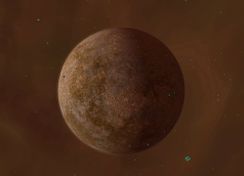
|
This wiki is closed in favour of the new wiki. Information shown is likely to be very out of date. |
Difference between revisions of "Sulza"
From Discovery Wiki
Jump to navigationJump to search (Lyck was renamed to Sulza in 4.90.2. Infobox name, pic file & Infocard fixed) |
|||
| Line 1: | Line 1: | ||
{{Version|4.90.2}} | {{Version|4.90.2}} | ||
{{Planet Infobox | {{Planet Infobox | ||
| − | | name = | + | | name = Sulza |
| − | | image = | + | | image = Sulza.jpg |
| owner = | | owner = | ||
| system = [[Thuringia]] | | system = [[Thuringia]] | ||
| Line 15: | Line 15: | ||
| escape_velocity = N/A | | escape_velocity = N/A | ||
}} | }} | ||
| − | This is a barren dwarf moon with no atmosphere, pockmarked by asteroid impact craters. It is the most massive of [[Planet | + | This is a barren dwarf moon with no atmosphere, pockmarked by asteroid impact craters. It is the most massive of [[Planet Weimar|Weimar's]] moons, which may be due to a large Iron-[[Nickel]] core. Sulza appears to have a solid core, as scans for thermal signatures and surface changes have revealed no evidence of active volcanism. |
[[Category: Rheinland]] | [[Category: Rheinland]] | ||
Revision as of 16:43, 6 November 2018
Article possibly outdated (
This article has not been verified to be up to date for the latest version of the Discovery mod. The last edit was made on 06.11.2018 (DD/MM/YYYY). You may help by updating it, often by using the code generator.
v4.90.2
)This article has not been verified to be up to date for the latest version of the Discovery mod. The last edit was made on 06.11.2018 (DD/MM/YYYY). You may help by updating it, often by using the code generator.
| Sulza | |
| Owner | unknown |
| Location | 6F, Thuringia |
| Technical information | |
| Population | unknown |
| Docking | N/A |
| Terrain | N/A |
| Diameter | N/A |
| Mass | N/A |
| Temperature | N/A |
| Escape velocity | N/A |
This is a barren dwarf moon with no atmosphere, pockmarked by asteroid impact craters. It is the most massive of Weimar's moons, which may be due to a large Iron-Nickel core. Sulza appears to have a solid core, as scans for thermal signatures and surface changes have revealed no evidence of active volcanism.
